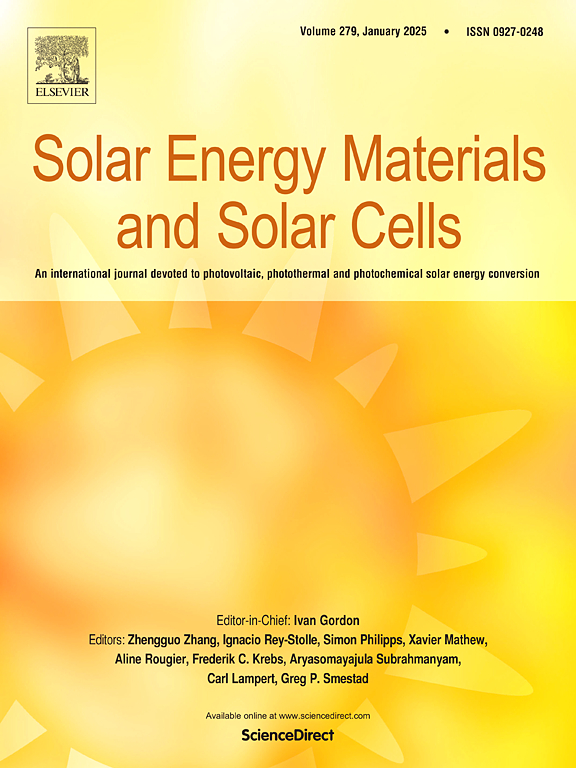形态稳定相变材料与导电ZnO/MnO2纳米颗粒集成光伏板的性能表征、实验研究与优化
IF 6.3
2区 材料科学
Q2 ENERGY & FUELS
引用次数: 0
摘要
本研究合成了三种形式稳定的共晶相变材料(FS-EPCMs),它们具有不同的docosane/coconut oil比例(30/70,50/50和70/30),以获得不同的熔点和潜热。为了提高热导率,将合成的ZnO/MnO2纳米颗粒逐层掺入FS-EPCMs中。响应面法(RSM)优化了PV板的温度和电效率,其中椰子油体积分数、FS-EPCM厚度和ZnO/MnO2重量分数被认为是显著因素(低p值)。方差分析揭示了影响电效率的关键相互作用,高f值(温度为212.70,效率为185.05)和低p值(<0.0001)表明模型显著性。较高的R2值(温度为0.9974,效率为0.9970)和调整后的R2值(0.9927,0.9916)表明模型拟合较好,“足够的准确性”得分(49.87,44.14)进一步支持了模型拟合。ZnO/MnO2纳米颗粒的加入显著提高了光伏板的冷却效果。当FS-EPCM悬浮液中含有45.30%的椰子油、55.70%的docosane和16.64% wt的ZnO/MnO2纳米颗粒,厚度为2.477 cm时,获得了最佳性能,导致面板温度为48.51°C,电效率为13.11%。本文章由计算机程序翻译,如有差异,请以英文原文为准。
Characterization, experimental study and optimization of the performance of photovoltaic panel integrated with form-stable phase change materials and conductive ZnO/MnO2 nanoparticles
This study synthesized three form-stable eutectic phase change materials (FS-EPCMs) with varying docosane/coconut oil ratios (30/70, 50/50, and 70/30) to achieve different melting points and latent heats. To improve thermal conductivity, layer-by-layer synthesized ZnO/MnO2 nanoparticles were incorporated into the FS-EPCMs. Response surface methodology (RSM) optimized PV panel temperature and electrical efficiency, with the coconut oil volume fraction, FS-EPCM thickness, and ZnO/MnO2 weight fraction identified as significant factors (low p-values). ANOVA revealed key interactions influencing electrical efficiency, with high F-values (212.70 for temperature, 185.05 for efficiency) and low p-values (<0.0001) demonstrating model significance. High R2 values (0.9974 for temperature, 0.9970 for efficiency) and adjusted R2 values (0.9927, 0.9916) indicate strong model fit, further supported by "Adequate Accuracy" scores (49.87, 44.14). Incorporating ZnO/MnO2 nanoparticles significantly enhanced PV panel cooling. Optimal performance was achieved with a FS-EPCM suspension comprising 45.30 % coconut oil, 55.70 % docosane, and 16.64 % wt ZnO/MnO2 nanoparticles at a thickness of 2.477 cm, resulting in a panel temperature of 48.51 °C and an electrical efficiency of 13.11 %.
求助全文
通过发布文献求助,成功后即可免费获取论文全文。
去求助
来源期刊

Solar Energy Materials and Solar Cells
工程技术-材料科学:综合
CiteScore
12.60
自引率
11.60%
发文量
513
审稿时长
47 days
期刊介绍:
Solar Energy Materials & Solar Cells is intended as a vehicle for the dissemination of research results on materials science and technology related to photovoltaic, photothermal and photoelectrochemical solar energy conversion. Materials science is taken in the broadest possible sense and encompasses physics, chemistry, optics, materials fabrication and analysis for all types of materials.
 求助内容:
求助内容: 应助结果提醒方式:
应助结果提醒方式:


